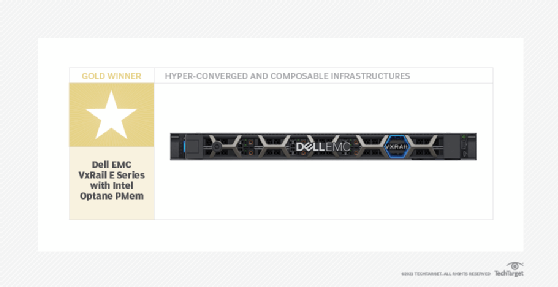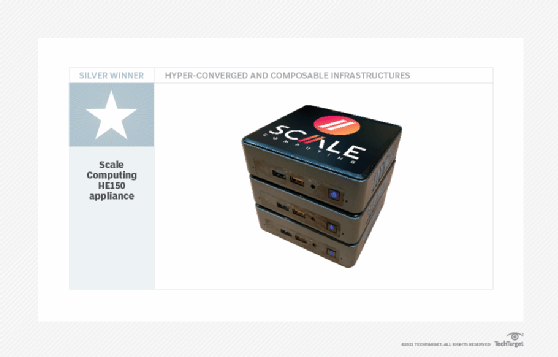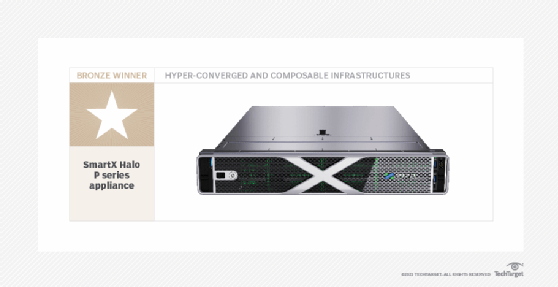
3dmentat - Fotolia
Top hyper-converged systems and composable infrastructure of 2020
Dell EMC, Scale Computing and SmartX win praise for multifaceted, edge-friendly and high-performance applications, respectively, to lead the way in the hyper-convergence category.
If there's one truth the COVID-19 pandemic has demonstrated for hyper-convergence, it's that the IT infrastructure paradigm's initial strengths remain important. For instance, the technology provided the VDI support that helped many organizations cope with an exponentially increased remote workforce. This year's winners in the Storage magazine and SearchStorage 2020 Products of the Year hyper-converged and composable infrastructures category demonstrate just how varied hyper-converged appliances have become as the market has matured and enterprise needs have changed.
The Dell EMC VxRail E Series with Intel Optane persistent memory (PMem) -- the gold winner in this category -- effectively balances leading-edge and proven technology like VMware vSAN 7 in an edge-friendly form factor. The appliance's Optane SSDs in App Direct Mode with integrated PMem move hyper-converged infrastructure (HCI) forward to deliver excellent performance for a variety of workloads.
Silver medalist Scale Computing HE150's small footprint, self-healing capabilities and portal management make it a particularly good option for edge computing deployments. Our bronze medalist -- the SmartX Inc. Halo P series appliance -- has impressive and practical ultralow latency that improves the performance of data-intensive operations, such as training machine learning models.
When talking about hyper-convergence, it's important to note that Dell Technologies has consistently led the market, and -- according to IDC's Sept. 2020 Worldwide Quarterly Converged Systems Tracker -- Dell EMC accounts for 28% of all hyper-converged systems sold. That's well ahead of second place Nutanix's 14% and third place HPE's 7%. Meanwhile, Dell Technologies subsidiary VMware dominates hyper-convergence software with a 38% share.
The Dell-VMware hyper-converged juggernaut is tough to beat. That's true when it comes to both market leadership and -- as our gold category winner proves -- quality and innovation.
Gold winner: Dell EMC VxRail E Series with Intel Optane persistent memory
This VxRail E Series model is a compelling product. It couples the simplicity you would expect from a vSAN experience with enterprise-grade hardware and services. As its name indicates, this hyper-converged system supports the full range of Intel Optane technologies, including PMem, which acts as a storage cache to help this VxRail E Series model deliver exceptional storage performance, such as accelerated database logging. Using Optane in App Direct Mode delivers better performance by expanding physical dynamic RAM capacity.
"The use of Intel Optane PMem in Application Direct Mode is leading edge," one judge said. "Only Oracle Exadata does it better."
Another judge cited a million IOPS performance per 128 GB PMem card as impressive, as well as linear IOPS scaling with additional cards. "There are few solutions as complete as the VxRail E Series with Optane PMem on the market," a third judge said. However, the value of Optane PMem will vary based on the target workloads, that judge cautioned.

Dell EMC jointly engineered the VxRail E Series with VMware, which should result in smoother deployments and management, as well as deep integration across the VMware ecosystem. "VMware vSAN has long defined the hyper-converged software category and continues to do so," according to one judge, who also noted how the container-centric feature set added to vSAN 7 will help VMware -- and by extension Dell EMC -- maintain its hyper-converged dominance.
The Dell EMC VxRail E Series with Intel Optane persistent memory also includes intelligent lifecycle management and is backed by more than 25,000 hours of testing. The base price of $15,800 per node, albeit with only three 7.68 TB SAS SSDs, is very competitive, noted a judge.
"Excellent performance for HCI and the simplicity of vSphere. Reasonably priced as well. Overall, a good value," concluded another judge.
Silver winner: Scale Computing HE150 appliance
The Scale Computing HE150 appliance is notably among the first -- if not the first -- fully functional, small form factor HCI node based on Intel's four-by-four inch Next Unit of Computing (NUC) mini-computer. This impressed our judges across the board.
NUC makes this hyper-converged system roughly the size of an Apple TV set-top box "without sacrificing the HCI features that enterprises expect," one judge said. Its compactness and capabilities make the HE150 an excellent option for edge computing deployments.

Scale Computing's miniature hyper-converged system includes remote and fleet management capabilities, with a single administrative interface that can manage thousands of deployments scattered across locations. Meanwhile, the vendor's patented HyperCore technology provides machine learning capabilities for detecting and mitigating infrastructure issues.
The HE150 appliance is also based on a clustered back-end architecture that maximizes uptime and doesn't require VMware or a hypervisor license. As another judge noted, "using Scale Computing's proprietary hypervisor/virtualization platform makes it both cheaper and less complicated to deploy in remote environments that might lack IT."
"Bonus points for using an NVMe drive," said another judge, who nonetheless dinged the HE150 appliance for lacking 10 Gigabit Ethernet (GbE) support and rack or case options to neatly package three nodes in a chassis.
However, "it's an ideal solution for a lights-out location -- i.e., no admins -- IoT and lots of distributed offices," the same judge added. Furthermore, at $5,000 for a three-node cluster, the HE150 appliance can create cheap, high-availability environments for IoT and remote manufacturing or logistics locations.
"The HE150 is priced effectively for that market," declared another judge. Scale Computing delivers "good value" to enterprises requiring fully functional hyper-converged computing at the edge.
Bronze winner: SmartX Halo P series appliance
"The Halo P is a performance beast. Anyone looking to deploy the HCI model for very demanding workloads need look no further," said a judge about dark horse bronze medalist SmartX Inc.'s hyper-convergence product.
The SmartX Halo P series appliance is another Optane PMem hyper-converged system optimized for Intel App Direct Mode. However, unlike our gold winner, the Halo P series is configured for high-end workloads like financial transactions and machine learning development. As such, this hyper-converged system at $70,000 per node is much more expensive than Dell EMC's product. That price includes a terabyte of PMem (8 x 128 GB), 192 GB RAM, 12.8 TB of NVMe (4 x 3.2 TB) and two 100 GbE network interface cards.
Judges found the SmartX Halo P series appliance's implementation of persistent memory and overall performance particularly noteworthy. One even ranked the SmartX Halo P series first in this category, drawing attention not just to Optane memory and Intel App Direct Mode, but also to the hyper-converged system's SmartX SMTX OS, high VM density support, less than 100 microsecond latency, 1.2 million IOPS, 25 GB sequential bandwidth -- more than twice that of typical mainstream mid- to high-end all-flash arrays -- and remote direct memory access over Converged Ethernet networking.

Like the Dell EMC VxRail E Series model, the SmartX Halo P series offers both VMware ESXi and Citrix XenServer virtualization. And while it's the priciest of the hyper-converged systems to medal this year, one judge cited the SmartX Halo P series as "overall a good system at a reasonable value" for the demanding workloads it supports.
Another judge noted, "the ultralow latency of the SmartX Halo P is impressive and can improve performance of data-intensive operations, such as training machine learning models," just one example of its target high-performance workloads.
Get the complete listing of the Storage magazine and SearchStorage 2020 Products of the Year category winners.







